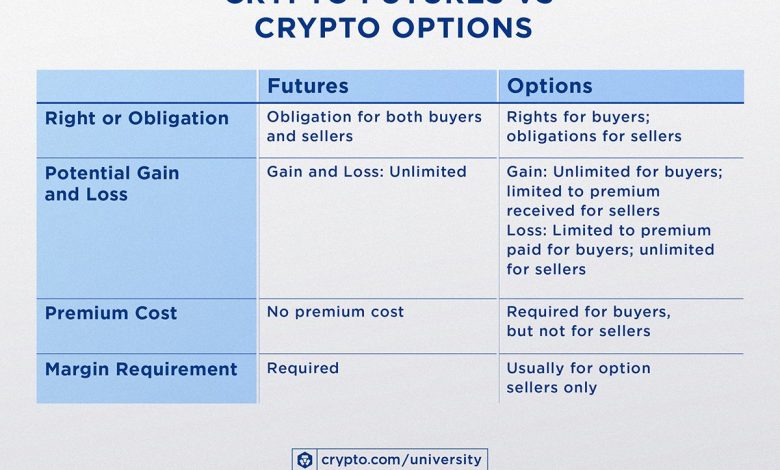Understanding Crypto Futures and Options

- Introduction to Crypto Futures and Options
- Exploring the Basics of Crypto Derivatives
- Benefits of Trading Crypto Futures and Options
- Risks Associated with Crypto Derivatives Trading
- Strategies for Successful Trading in Crypto Futures and Options
- Regulatory Environment for Crypto Derivatives Markets
Introduction to Crypto Futures and Options
Crypto futures and options are financial derivatives that allow investors to speculate on the price movements of cryptocurrencies without actually owning the underlying assets. These instruments are popular among traders looking to hedge their positions or amplify their returns in the volatile crypto market.
Unlike spot trading, where assets are bought and sold for immediate delivery, futures and options contracts are agreements to buy or sell assets at a predetermined price on a future date. This provides traders with the opportunity to profit from both rising and falling prices, depending on their market outlook.
One of the key advantages of crypto futures and options is leverage, which allows traders to control a larger position with a smaller amount of capital. While this can amplify profits, it also increases the risk of losses, making these instruments suitable for experienced traders who understand the market dynamics.
Exploring the Basics of Crypto Derivatives
Crypto derivatives are financial instruments that derive their value from an underlying asset, such as a cryptocurrency. Two common types of crypto derivatives are futures and options. These derivatives allow traders to speculate on the price movements of cryptocurrencies without actually owning the underlying assets.
Crypto futures are contracts that obligate the buyer to purchase an asset at a predetermined price on a specified future date. Conversely, the seller is obligated to sell the asset at that price. This type of derivative allows traders to profit from both rising and falling cryptocurrency prices.
Crypto options, on the other hand, give traders the right, but not the obligation, to buy or sell an asset at a predetermined price within a specified time frame. This provides traders with more flexibility compared to futures contracts, as they can choose whether or not to exercise their option based on market conditions.
Both crypto futures and options are popular among traders looking to hedge their risks or speculate on the price movements of cryptocurrencies. By using these derivatives, traders can potentially amplify their profits or limit their losses, depending on their trading strategies and market conditions.
Benefits of Trading Crypto Futures and Options
Trading crypto futures and options can offer a range of benefits for investors looking to diversify their portfolios and manage risk effectively.
- **Leverage**: One of the main advantages of trading crypto futures and options is the ability to use leverage. This means that traders can control a larger position with a smaller amount of capital, potentially increasing their profits.
- **Hedging**: Futures and options can also be used as a hedging tool to protect against price fluctuations in the crypto market. By taking a position that offsets potential losses in their existing holdings, investors can mitigate risk.
- **Diversification**: Trading futures and options allows investors to gain exposure to a wide range of cryptocurrencies without having to own the underlying assets. This can help diversify their portfolios and reduce overall risk.
- **Flexibility**: Futures and options contracts come with a variety of expiration dates and strike prices, giving traders the flexibility to tailor their positions to their specific investment goals and risk tolerance.
- **Liquidity**: The futures and options markets for cryptocurrencies are highly liquid, meaning that traders can easily enter and exit positions without impacting market prices. This can help ensure that investors get fair prices for their trades.
Overall, trading crypto futures and options can be a valuable addition to an investor’s toolkit, offering opportunities to profit from both rising and falling markets while managing risk effectively.
Risks Associated with Crypto Derivatives Trading
Trading crypto derivatives such as futures and options can be lucrative, but it also comes with its fair share of risks that traders need to be aware of. Some of the risks associated with crypto derivatives trading include:
- **Volatility:** The crypto market is known for its high volatility, which can lead to significant price fluctuations in a short period of time. This can result in substantial losses for traders.
- **Leverage:** Many crypto derivatives platforms offer leverage, allowing traders to control a larger position with a smaller amount of capital. While leverage can amplify profits, it can also magnify losses.
- **Liquidity:** The liquidity of the crypto derivatives market can vary, especially for less popular assets. This can make it difficult to enter or exit trades at desired prices.
- **Regulatory:** The regulatory environment for crypto derivatives is still evolving, and changes in regulations can impact the market and traders’ ability to trade.
- **Counterparty Risk:** When trading derivatives, traders are exposed to counterparty risk, the risk that the other party in the trade will not fulfill their obligations.
It is essential for traders to carefully consider these risks before engaging in crypto derivatives trading and to use risk management strategies to protect their capital. By staying informed and being cautious, traders can navigate the crypto derivatives market more effectively and minimize potential losses.
Strategies for Successful Trading in Crypto Futures and Options
When it comes to trading in crypto futures and options, there are several strategies that can help you navigate this complex market successfully. Here are some key tips to keep in mind:
- Do your research: Before diving into crypto futures and options trading, make sure you understand the market and the various factors that can impact prices.
- Set clear goals: Define your trading goals and risk tolerance before making any trades. This will help you stay focused and avoid emotional decision-making.
- Diversify your portfolio: Spread your investments across different assets to reduce risk and increase potential returns.
- Use stop-loss orders: Implementing stop-loss orders can help you limit your losses and protect your capital in case of unexpected market movements.
- Stay informed: Keep up to date with the latest news and developments in the crypto market to make informed trading decisions.
By following these strategies, you can increase your chances of success in crypto futures and options trading. Remember to always trade responsibly and never invest more than you can afford to lose.
Regulatory Environment for Crypto Derivatives Markets
The regulatory environment for **crypto derivatives markets** plays a crucial role in shaping the landscape for **crypto futures and options** trading. As the popularity of **cryptocurrencies** continues to grow, regulators around the world are paying closer attention to these **financial instruments** to ensure investor protection and market integrity.
One key aspect of the regulatory framework for **crypto derivatives** is the requirement for exchanges to obtain proper licensing and adhere to strict compliance standards. This helps to prevent fraud, market manipulation, and other illicit activities that can harm investors and undermine the credibility of the **crypto market**.
Regulators also impose rules on leverage limits, margin requirements, and reporting standards to mitigate risks associated with **crypto derivatives** trading. By setting clear guidelines and monitoring compliance, regulators aim to create a more transparent and stable **trading environment** for **cryptocurrency** investors.
Moreover, regulatory oversight can help to foster institutional participation in **crypto derivatives markets** by providing a level of assurance and legitimacy that traditional **financial institutions** require. This can lead to increased liquidity, tighter spreads, and overall improved market efficiency for **crypto futures and options**.
Overall, a well-defined regulatory environment is essential for the long-term sustainability and growth of **crypto derivatives markets**. By striking a balance between innovation and investor protection, regulators can help to unlock the full potential of **cryptocurrencies** as a new asset class for **financial markets**.
